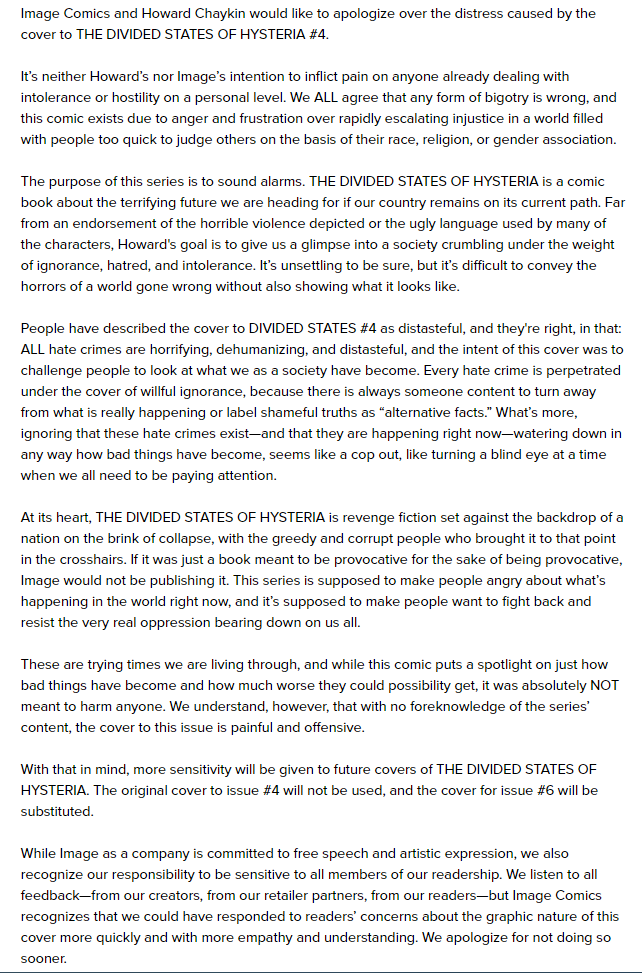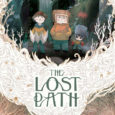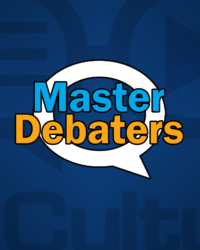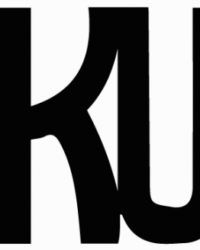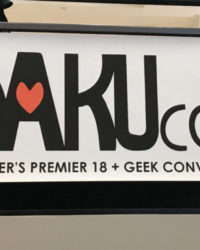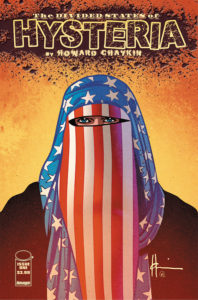 There’s been a lot of talk about boycotting Image Comics over the past two weeks. Those feelings are valid. I feel them too. However, I want to address why this would not work and open up the conversation to alternative courses of action. I’ll discuss what led readers to this decision, how Image makes their money, who a boycott will actually hurt, and ultimately what we can do together to help change happen.
There’s been a lot of talk about boycotting Image Comics over the past two weeks. Those feelings are valid. I feel them too. However, I want to address why this would not work and open up the conversation to alternative courses of action. I’ll discuss what led readers to this decision, how Image makes their money, who a boycott will actually hurt, and ultimately what we can do together to help change happen.
A SERIES OF UNFORTUNATELY SHITTY EVENTS
By now, we have all seen the cover to The Divided States of Hysteria #4, the latest title by longtime comic creator, Howard Chaykin. If you haven’t, here is a link to it, but I do warn you: it’s fucked up. From the racial slur to the mutilation, there’s nothing that sits right about this cover. As Comicosity put it:
“There’s nothing thought-provoking about the lynching depicted on the cover of issue #4. Chaykin chose to put a racial slur on the dead man’s name tag. Not spray painted on the wall by him, not written on him in blood. On his name tag. Chaykin decided that the value of the life of the victim he was portraying was so little that he didn’t even deserve an actual name. Just a slur.”
(If you’re pretty up to date on the events surrounding this cover, you can skip down to subsection “THE CALL TO BOYCOTT.”)
This is the latest in a quick series of affronts to marginalized readers regarding this title.
For one thing, The Divided States of Hysteria is a story about “an America shattered by greed and racism, violence and fear, nihilism and tragedy.” While not an intrinsically terrible premise, the writing itself is problematic. Chaykin’s characters use transphobic language in the very first issue while enacting violence against a transgendered sex worker named Chrissie. Transgender individuals already face heightened chances of violence according to a recent study, so why punch down on a group that experiences this as a fact of life?
Secondly, while the title isn’t the first to use this incendiary sort of story telling, having it released during Pride month is tone-deaf at the very least. Image Comics did such a huge promotion for its Pride variants, even releasing one starring Chrissie, that this felt like a slap in the face to the LGBTQIA community. It instead renders the gesture empty, making it a venture capitalizing on struggles we face daily.
Then, when first pressed for comment, Image declined. At this, most people curled their lip and readers were vocal about using their money to support books by other publishers instead. The outrage simmered down after a few days.
Most recently, Image released solicitations, or previews for upcoming issues which feature cover art, for The Divided States of Hysteria #4, as mentioned above. In the aftermath of a slew of rightfully angered comments, tweets, and emails, Image and Chaykin finally issued a statement:
There’s several questions that still need to be answered: Can we do anything as readers? How do these comics get approved when comics are such a collaborative medium, requiring many eyes before the book reaches the shelf? How can we stop supporting a publisher who lets this thing slide?
 LET’S TALK ABOUT IMAGE COMICS
LET’S TALK ABOUT IMAGE COMICS
Image Comics was originally created to represent creators who weren’t being appreciated by DC and Marvel for their work back in the early 1990s. In addition to a different business model, namely taking a fixed fee upon publication for the company’s administrative costs in exchange for the creator keeping all creative rights to their property, Image also doesn’t generally interfere creatively. Every comic published by Image lists their entire staff, right there in the masthead. There is no editorial staff, unless the creators themselves hire one, directly out-of-pocket. I spoke to a creator, who chose to remain anonymous, a little more about how this works:
“…to the best of my knowledge, no one looks at the files until the book goes into actual production. Now, this wouldn’t be true for things like covers, which are used for promo and marketing, but content wise there aren’t any checks on stuff that I’m aware.”
For a publisher that prides itself on being diverse, why isn’t more care given to the stories published? It could be because most creators behind current Image titles are predominantly cisgendered white males. It could be because publishers have consistently capitalized on minority experiences instead of celebrating them. Either way, for a supposedly “progressive” leader in independent comics, it’s a handful of specific creators that have made Image seem so forward-thinking. Image is progressive by default, when you compare them to the constant missteps by both DC and Marvel, and consider that a lot of newer readers enter the comic world through the award-winning Saga.
Overall, Image might have this reputation for being alternative and a breath of fresh air in the grand lineup of superhero books, but when you scrutinize the teams behind the books, it really isn’t. It’s hard to forget they’re a company who first and foremost want to make money. This is where readers come in.
THE CALL TO BOYCOTT
While I am certainly not going to tell anyone not to boycott, I do feel it’s my duty as a retailer to lay out why a blanket boycott will hurt brick and mortar shops without impacting the publisher itself. I stress that it’s very different to boycott a creator whose work you don’t care for versus an entire publisher.
Why does a blanket boycott hurt shops and not the publisher? A shop has to pay for comics about three months before they hit shelves. This means the publisher has already been paid, usually before reviews have come out, and before the public at large learns of the book. This is why a Previews catalogue is so important: it highlights upcoming books from all publishers, toys, shirts, merchandise, you name it. You can sign up and preorder anything in that catalogue at your local comic shop. And you should– that way shops can order the correct amounts of new product for their individual shelves.
Otherwise… shops have to take a guess. Some shops employ POS systems that track every bar code that goes out the door, and some do it all by paper and pencil, which works great for titles that have already come out and have an established fanbase. For new titles, we have to essentially wing it and put faith into it without having read it, in the hopes that it will sell. This is a much easier bet to make for bigger publishers like Marvel, DC, and Image than it is for smaller publishers.
Where a large corporation can handle a boycott by laying off people or raising the price of a product to offset the money lost, Image would have to cancel titles. It wouldn’t be titles like The Walking Dead either, it’d be the ones with smaller, dedicated fanbases that may not have high print numbers.
I asked my creator friend about this as well:
“It’s for sure going to hurt shops first and more. As you know, comic shops are buying stuff non returnably. So if, say, the entire customer base of a store decided at once to stop buying Image (or any other publisher) while the shop could adjust for future orders, they’re stuck with the stock they have. And stores, typically, have a lot less margin for that sort of thing than publisher.
In the specific case of Image, the next person up the chain, in terms of being hurt, are the creative teams. Image doesn’t profit off singles, and they only profit a little off of the rest. It’s hypothetically possible enough boycotting could reduce the number of titles they have and hurt them financially like that, or hurt trade enough, but by nature of the comics market and the Image model, you’re always going to be preferentially hurting shops and creators.
A boycott that was actually effective would hurt marginal titles most. Saga can lose 50% of it’s audience and still be profitable. The Few couldn’t.”
So, what can we do?
PATHS OF ACTION
Be vocal about why you’re not purchasing a book in as many places as you feel comfortable. Utilize hashtags, tag the publisher, tweet about what you are purchasing instead! You can launch a movement with peers and use the tools at your disposal to bring attention to the issue at hand, much like people did with Milo Whatshisface’s book under Simon & Schuster. Maybe it’ll be canceled and maybe it won’t be. There’s not a precedent for that exactly, but we can chalk that up to being disorganized about how we have been going about this. There’s also a wider range of representation happening than ever before, and until the creators ARE the people represented, there’s bound to be mistakes here and there. As long as there’s an honest conversation, progress can be made.
It shouldn’t fall on readers, both new and old, to constantly strive for change when it should come from within the industry. The same old white creators with the same old ideas should be encouraged to use their reputation and clout to fill their teams with people of color, women, queer people.
Whatever you do, DO NOT tag and/or attack the creator in your missives. Even if they’re the actual worst, they’re still people at the end of the day.
Focus on individual titles, look up your favorite creators and support their endeavors, either by buying their other work at a convention, commissioning a piece of art, signing up for their patreon, etc. Don’t be afraid to vote with your dollar.
It’s time for the comics industry to stop failing us. Us being retailers, readers, creators. Let’s stop pushing away a new, hungry readership and welcome them by listening. Hire qualified younger people who can point out things that may be easily missed. Get consultants on books if a publisher insists that same old creator writes a character with vastly different life experiences. Hell, just take a lap around a convention’s artist alley and take it in. See what people are buying and are excited about. These are new readers. These are people barely getting into books. These are seasoned fans reaching for something new. Yes, even the women ogling everything Kevin Wada has on sale. Yes, even the dudes purchasing J. Scott Campbell prints. Yes, even the queer people picking up that hard to find Pop figure. Yes, even the children standing in line to get a photo with Stan Lee.
Let’s do this together.


